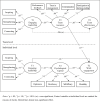The impact of engaging leadership on employee engagement and team effectiveness: A longitudinal, multi-level study on the mediating role of personal- and team resources
- PMID: 35767536
- PMCID: PMC9242457
- DOI: 10.1371/journal.pone.0269433
The impact of engaging leadership on employee engagement and team effectiveness: A longitudinal, multi-level study on the mediating role of personal- and team resources
Abstract
Most research on the effect of leadership behavior on employees' well-being and organizational outcomes is based on leadership frameworks that are not rooted in sound psychological theories of motivation and are limited to either an individual or organizational levels of analysis. The current paper investigates whether individual and team resources explain the impact of engaging leadership on work engagement and team effectiveness, respectively. Data were collected at two time points on N = 1,048 employees nested within 90 work teams. The Multilevel Structural Equation Modeling results revealed that personal resources (i.e., optimism, resiliency, self-efficacy, and flexibility) partially mediated the impact of T1 individual perceptions of engaging leadership on T2 work engagement. Furthermore, joint perceptions of engaging leadership among team members at T1 resulted in greater team effectiveness at T2. This association was fully mediated by team resources (i.e., performance feedback, trust in management, communication, and participation in decision-making). Moreover, team resources had a significant cross-level effect on individual levels of engagement. In practical terms, training and supporting leaders who inspire, strengthen, and connect their subordinates could significantly improve employees' motivation and involvement and enable teams to pursue their common goals successfully.
Conflict of interest statement
The authors have declared that no competing interests exist.
Figures
References
-
- Schaufeli W.B., Salanova M., González-Romá V., Bakker A.B. The measurement of engagement and burnout: A two sample confirmatory factor analytic approach. Journal of Happiness Studies. 2002; 3(1), 71–92. https://doi.org10.1023/A:1015630930326.
-
- Schaufeli W.B. Applying the Job Demands-Resources model: A ‘how to’ guide to measuring and tackling work engagement and burnout. Organizational Dynamics. 2017; 46(2), 120–132. 10.1016/j.orgdyn.2017.04.008. - DOI
-
- Bakker A.B., Demerouti E. The job demands-resources model: State of the art. Journal of Managerial Psychology. 2007; 22(3), 309–328. 10.1108/02683940710733115. - DOI
MeSH terms
LinkOut - more resources
Full Text Sources



